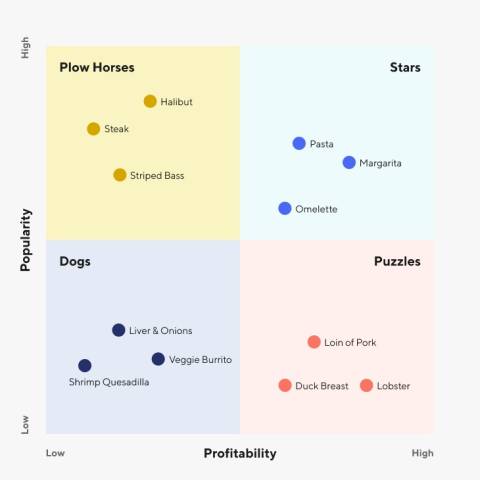For restaurant owners, finding the perfect balance between costs and profits is an ongoing process. Menu engineering is a tried-and-true strategy to identify which items on your menu are contributing to — or taking away from — your bottom line. In this article, we'll explain the basics of menu engineering and share how to use those insights to design your menu for profit.
What is menu engineering?
Menu engineering is the practice of analyzing the profitability and popularity of your individual menu items. By understanding which dishes drive the most sales and profits and finding opportunities to improve underperforming items, restaurant operators can determine the best pricing strategy and menu design for their business.
How to conduct a menu engineering analysis
A menu engineering analysis can be completed in three steps:
Calculate the food cost and profit margin of each item
Categorize all menu items by profitability and popularity
Optimize your menu
1. Calculate food cost percentage of each item
Start the menu engineering process by calculating the food cost of every menu item — in other words, the cost of the ingredients used to make a dish, including oil, garnishes, and seasonings — as well as the sales volume of each item during a recent time period.
Many restaurants are able to automatically calculate their food cost by integrating their POS system with their inventory management software. Calculating your food cost by hand will require quite a bit more time and effort, but can be done if you have accurate, detailed inventory and sales records.
List each ingredient that goes into this dish and their cost, then determine the quantity of each ingredient that goes into each dish so you can calculate the cost per serving.
Food Cost Per Dish = Total Cost of Ingredients Per Serving
Then, to understand how each dish contributes to your food profits — known as the contribution margin — simply subtract the food cost from the item's menu price.
Contribution Margin = Menu Price – Item Cost
2. Categorize menu items by profitability and popularity
Next, use this data to group menu items into categories that determine popularity and profitability. One common way to map this data is to create a menu matrix, where the X axis is the item's contribution margin, and the Y axis is volume sold during your specified timeframe.

The four quadrants of the matrix represent the four quirkily named menu engineering categories:
Stars (upper right): High profitability and high popularity
Plow-horses (upper left): Low profitability and high popularity
Puzzles (lower right): High profitability and low popularity
Dogs (lower left): Low profitability and low popularity
3. Optimize your menu
Now that you have a visual representation of which items are making a positive or negative impact on your business, it's time to adjust your menu to improve your restaurant profit margin.
Below are some strategies for each menu engineering category:
Stars: With high profitability and high popularity, these items should be featured prominently on your menu. Your customers love them, and they're helping to boost your restaurant profit margin. Consider promoting these dishes across your menu and marketing channels, but try to avoid making major changes to the recipe or price — as they are clearly working for you and your guests.
Plow-horses: With low profitability but high popularity, the goal with these crowd-pleasing dishes is to keep them on your menu but make tweaks to increase their contribution margin. Try increasing the item's price, or decreasing its food cost by swapping in more budget-friendly ingredients, finding more affordable suppliers, or decreasing the portion size.
Puzzles (lower right): These profitable yet unpopular dishes could improve your margins if you can figure out how to sell more of them. Perhaps you can boost their popularity by prominently featuring the dish with photos on your menu, making its name or menu description more clear or appealing, training your staff to recommend it, or educating followers about it on social media.
Dogs (lower left): With low profitability and low popularity, it's time to consider removing these dishes from your menu, or at least minimizing them on your menu design. If you're not ready to part with this dish yet, take major steps to decrease the food cost, optimize the menu price, and make it more enticing to customers through menu placement, photos, and descriptions.
Menu psychology tips: How to redesign your menu for profit
Now that you have a plan for optimizing your menu for profit, it's time to rethink your menu design and layout with these insights in mind. Menu psychology strategies help persuade your guests to order certain items by using visual cues, thoughtful positioning, strategic pricing (e.g., $9.95 instead of $10), and more. These techniques will help you highlight and promote the items that have the most impact on your restaurant profit margin.
Redesign your layout: The order and placement of your menu items is a big part of menu psychology and menu design. One theory, known as the Golden Triangle, posits that customers' eyes start on the middle of the menu, then move to the top right, then the top left. That means you can place your Stars and Puzzles in those three areas. You can also use design elements such as bold fonts, colors, and callout boxes to prominently feature profitable items.
Stimulate appetites with photos: Properly executed menu photography will pique diners' interest in dishes they've never tried before, entice them to come back, and drive sales of profitable items. In fact, DoorDash data indicates that adding high-quality photos to your menu can increase delivery volume by 15%. Show off your dishes in the most appetizing way by using natural lighting, minimalist plating, and flattering angles.
Write compelling menu descriptions: Craft menu descriptions that go beyond a list of ingredients and give a preview of the guest experience. Provide a vivid teaser of the dish's taste, appearance, and texture, and use luxurious adjectives like rich, creamy, tender, and succulent. At the same time, be sure to keep your descriptions short, accurate, and easy to understand.
Track the impact of your menu engineering efforts
Once you've completed your menu engineering analysis and menu redesign, it's critical to monitor your sales data to understand the impact of your efforts. Did your Puzzles gain popularity after you updated the menu layout? Are customers still ordering Plow-horses even after you swapped in lower-cost ingredients? Continue to track your sales, profitability, and food costs in your POS or other business records and adjust menu strategies as needed. And for off-premise orders, DoorDash partners can track sales volume, popular items, and more in the Merchant Portal.
Menu engineering is not a one-time task, but an ongoing process. Create a cadence to conduct menu engineering analyses on a regular basis — whether it's twice per year or every month, choose a schedule that you know you'll stick to. With these strategies in mind, your restaurant will be on its way to higher profit margins.





